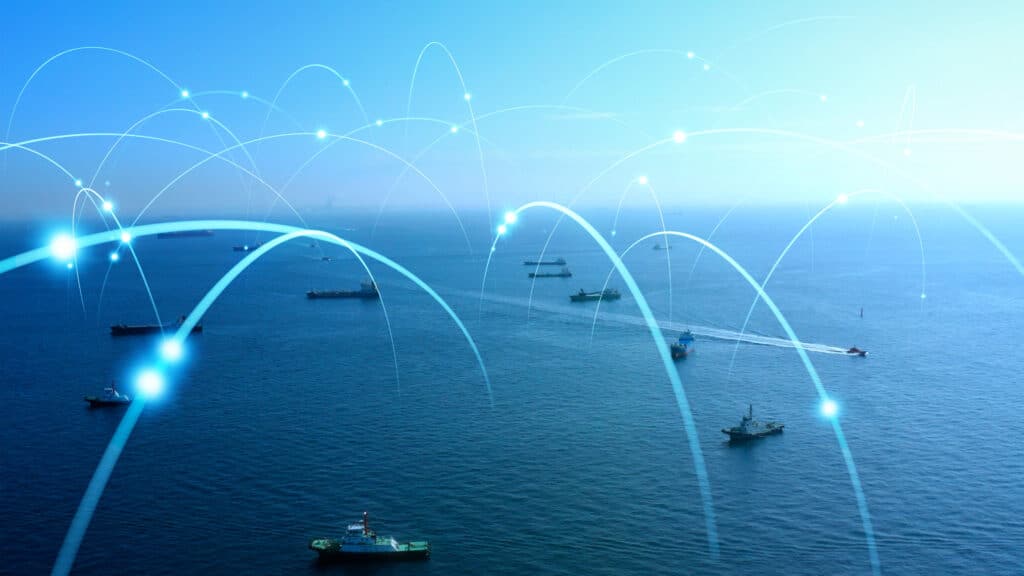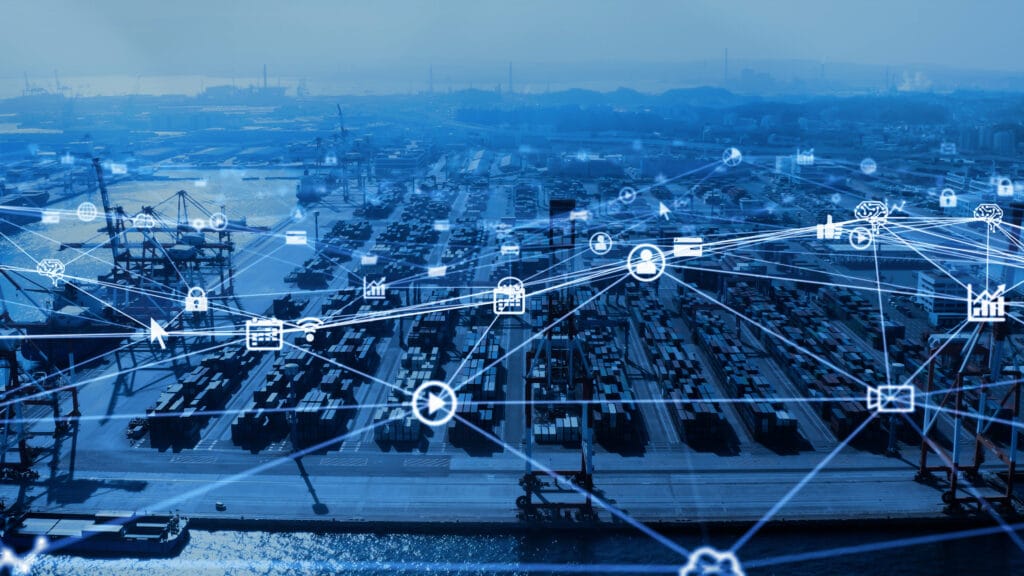Most of the world’s biggest ports use a specific system to ease information exchange between all parties that have activities related to port. A Port Community System is a National Single Window that links individual seaports and all supply chain actors. This unique platform automates data and knowledge real-time sharing and allows better interaction management within the network.
Definition of a port community system
According to The International Port Community Systems Association (EPCSA), a Port Community System (PCS) is an open electronic platform that connects individual existing systems and databases of distinct companies and organizations. The main purpose of the PCS is to enable secure and intelligent operational data exchange and consolidation within the port network.
The seaport community involves public and private stakeholders that can be divided into 2 categories:
- Users who are sending information: shipping lines, shipping agents, customs brokers, freight forwarders and logistics specialists, other transport services providers (truckers, chassis providers, rail, barge…) and their respective teams, inland terminal operators, warehouses managers, shippers, and cargo owners.
- Official entities who are receiving information: port managers and operators, customs authorities, immigration offices, and government agencies such as Food and Consumer Product Safety Authority.
A PCS is a neutral and open platform that should act as a Trusted Third Party. This means that it cannot be operated by a port operator or by the port authority, but rather by an independent entity. It can be a public, private or public/private organization that is led by a board of directors and is composed of representatives of groups within the port and the logistics community.
How Is ETA Computed Using Artificial Intelligence ?
The ETA computations explained are to help ports and the shipping industry understand how ETA is computed and how important a precise ETA is for their business activities. ETA is one of the most influential factors for maritime supply chain efficiency…
How does a Port Community System bring value to the maritime industry?
Seaports are a vital component of the supply chains and international transportation. As such, they play a strategic role in coordinating goods and data flows. In order to be able to provide customers the agile service they are expecting, the seaports and logistics community processes must be aligned. The Port Community System helps the seaport be successful and create value for customers. By aggregating all databases and information systems on a single platform, this tool is aiming at:
- simplifying logistics procedures;
- reducing administrative formalities;
- increasing the seaport operational efficiency with streamlined processes;
- facilitating data interoperability despite format discrepancies;
- improving the global supply chain performance;
- optimizing port-related vessel traffic and cargo movement processes;
- boosting safety and predictability;
- ensuring compliance with international, national and regional regulations, guidelines and directives;
- moving forward to seaport business digitization;
- responding to the call for standardization made by the main shipping companies;
- helping the maritime industry to become greener and more sustainable (paperless transactions, reduced waiting and berthing time for ships, which lessens greenhouse gases emissions);
- contributing to the port network development.
Through single submission of data, PCS offers multiple operational benefits:
- seamless and transparent communications;
- safe and optimized management of all vessel calls and handling at ports, thanks to pre-arrival notification;
- greater visibility of port operations;
- high level of integration between sea and hinterland modes of transport that creates synergies;
- quicker custom processes and clearance of goods, that help for decongestion of ports;
- operational cost reduction;
- faster container movements;
- increased productivity for all stakeholders, especially seaports’ competitiveness;
- availability of reliable data that can be reused for a variety of related services;
- easy reporting: maritime statistics, vessel traffic, import and export cargo monitoring.
Renowned technology firms such as IBM, Accenture, Oracle and GE Transportation, but also startups and other entities like APM Terminals are developing solutions for large ports in Europe (Rotterdam, Marseille, Antwerp, Valencia), Asia (Singapore, Mumbai), the United States (Los Angeles, Long Beach, Oakland, Montreal) or Latin America (Vera Cruz) among others.

What challenges are raised by the implementation of a PCS?
Deploying a PCS solution comes with a number of challenges:
- some port users are not connected;
- there often is a strong competition for market share between companies in the same sector, which therefore may be reluctant to share information;
- a PCS may have its own internal standards depending on the port or region’s physical and operational characteristics, as well as the port management information system in place and the rules set for the National Single Window. As a result, there could be an amount of PCS recipes.
A common strategy has to be defined in order to ensure smooth cooperation. At least following aspects have to be included in such strategy:
- the conditions of the PCS setup;
- the technologies used;
- the platform’s accessibility anytime, anywhere, via any device with an Internet connection;
- the kind and formats of information to be shared;
Above points are essential to allow each PCS communicate with other similar systems using international standards.
How Is ETA Computed Using Artificial Intelligence ?
The ETA computations explained are to help ports and the shipping industry understand how ETA is computed and how important a precise ETA is for their business activities. ETA is one of the most influential factors for maritime supply chain efficiency…
What are the main technologies linked to the port community system?
The port community system connects a variety of electronic tools used by the network members:
- vessels automatic identification system (AIS) ship’s tracking; the device communicates the ship’s exact location and other information to nearby ships and shore-based receiving stations;
Customs system
- e-cargo declaration;
- remote payment of duties and taxes;
Shipping lines system
- e-booking of containers or space for general and bulk cargo;
- monitoring of physical movements of containers or goods;
- e-manifest data submission;
- release of carrier Delivery Order;
- track cargo status for importers or check ocean vessel schedules for exporters
Port system
- e-settlement of all bills: handling costs, logistics fees, demurrage charges;
- release of Terminal Delivery Order;
Haulage companies’ system
- make appointments to pick-up containers.
Conclusion about port community system
Port Community Systems will drive the supply chain performance, the maritime industry’s digitization and carbon-impact reduction in the next decades. They will benefit from the support of International organizations like the European Union, the United Nations Conference on Trade and Development (UNCTAD), the European Port Community Systems Association (EPCSA). These governmental initiatives’ aim is to strengthen the role of seaports in successful international trade.
However, as the PCS business grows, some factors will have a greater influence: software and hardware, legal framework, and last but not least, new technologies. Internet, data analytics, Artificial intelligence, Machine Learning, Big data, blockchain, Internet of Things, robotization will drive innovation, promote further integration and enable support wiser decisions to disrupt the actual way of doing business.
Frequently Asked Questions About: Tracking a ShipPort Community System
A series of maritime procedures aimed to ensure the smooth transition of vessels and their containers from one terminal to another
Ship operations include managing the crew, creating dry-docking requirements; overseeing dry docking, operational maintenance, and the preparation of insurance claims. Ship operations must also be financially vigilant which include costs, flexibly adapt to the constantly changing requirements of the maritime sector, ensure the ship has enough oil and fuel for the entire journey, and maintain close ties with customers, master sailors, and seafarers.
A Smart Port is a digital port. A Smart Port is a more effective, more performant, and more economically competitive port. Not only that, but Smart Ports consider residents key stakeholders in their activities. They use real-time information, a collaborative management approach, and essentially provide more with less.





